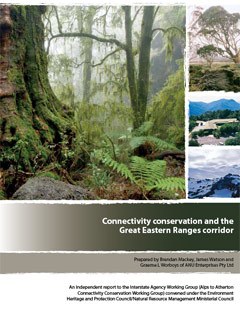Publications
Connectivity conservation and the Great Eastern Ranges corridor
| Year of publication | 2010 |
|---|---|
| Publisher(s) | Department of Environment, Climate Change and Water NSW Website: http://www.environment.nsw.gov.au/ger/inde... |
| ISBN/ISSN | 978 1 74232 216 2 |
| Language | en |
| Price | free |
| Purchase | http://www.environment.nsw.gov.au/resources/nature |
| Page(s) | 68 |
| Publication type | Other |
Connectivity conservation is based around the concept of 'landscape corridors' that maintain or establish multi-directional and multi-scale connections over entire landscapes and can encompass up to thousands of square kilometres. Connectivity conservation extends the concepts of biodiversity and biological corridors to the landscape scale. Elements of a landscape corridor include dispersal corridors (such as corridor networks and habitat corridors) and ecological corridors (which focus on landscape permeability for ecosystem processes).
The review concluded that there is strong scientific basis for connectivity conservation based on theoretical and empirical findings in Australia and internationally. Connectivity conservation builds upon the existing foundations of conservation science, which include:
- biological theory concerning the genetics, dynamics and viability of populations
- the equilibrium theory of island biogeography and metapopulation theory
- macroecology (the emergent statistical properties of ecological data sets)
- knowledge of historic, environmental and evolutionary biogeography.
Connectivity conservation is a logical extension of these foundations which is necessary given the scale of the current biodiversity extinction crisis and the potential synergistic impacts of climate change.
The review concluded that there is strong scientific basis for connectivity conservation based on theoretical and empirical findings in Australia and internationally. Connectivity conservation builds upon the existing foundations of conservation science, which include:
- biological theory concerning the genetics, dynamics and viability of populations
- the equilibrium theory of island biogeography and metapopulation theory
- macroecology (the emergent statistical properties of ecological data sets)
- knowledge of historic, environmental and evolutionary biogeography.
Connectivity conservation is a logical extension of these foundations which is necessary given the scale of the current biodiversity extinction crisis and the potential synergistic impacts of climate change.


